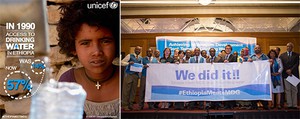The year 2015 sees the end of both Ethiopia’s GTP I and the planned first phase of the OWNP. It was also the target date set by the United Nations in 2000 for achieving the Millennium Development Goals (MDGs).
You will recall from Study Session 2 that there were eight MDGs, and that Goal 7 included the aim to halve, by the end of 2015, the proportion of people without sustainable access to safe drinking water and basic sanitation. The goal for basic sanitation has not yet been achieved but, after a concerted effort by the Ethiopian government, the public and development partners, in March 2015, Ethiopia celebrated meeting the target for water supply. This made Ethiopia one of the few countries in sub-Saharan Africa to fulfil this global commitment. Figure 15.7 shows a UNICEF poster designed for the event and the celebration by assembled stakeholders held at the Sheraton Hotel, Addis Ababa on 23 March 2015.

Figure 15.7 Celebrating the achievement of the water MDG in March 2015.
This was a great achievement for Ethiopia but, despite huge improvements across all eight goals across the globe, there are still many targets that have not been met. The global community has therefore developed a new set of goals called the ‘Sustainable Development Goals’.
The Sustainable Development Goals (SDGs) were finalised at a world summit in September 2015. There are 17 goals, rather than the previous eight, allowing more specific details to be included. Box 15.1 has details of the goal that relates to WASH.
Goal 6, which applies to WASH, is: ‘Ensure access to water and sanitation for all’. It has the following specific targets:
(UNDP, 2015)
You can see that these new goals introduce aspects of water management that were not included in the MDGs. Water quality, for example, has been added in recognition of the problems caused by pollution and the impact this can have on the availability of usable water. Inclusion of water quality targets brings another dimension that could affect the OWNP implementation.
What other impacts will these new goals have on the WASH programme in Ethiopia? In short, we don’t know. The previous MDG was framed in terms of halving proportions, but the new SDG is less compromising and requires availability for all by 2030. The current OWNP Phase 2 is scheduled to end in 2020, and already has the target of 100% access to water and sanitation by that time. If it succeeds that will precede the SDG target by ten years! There are great challenges ahead in achieving this target, but the harmonisation, integration, alignment and partnership principles of the OWNP will all be profoundly important in achieving this goal.